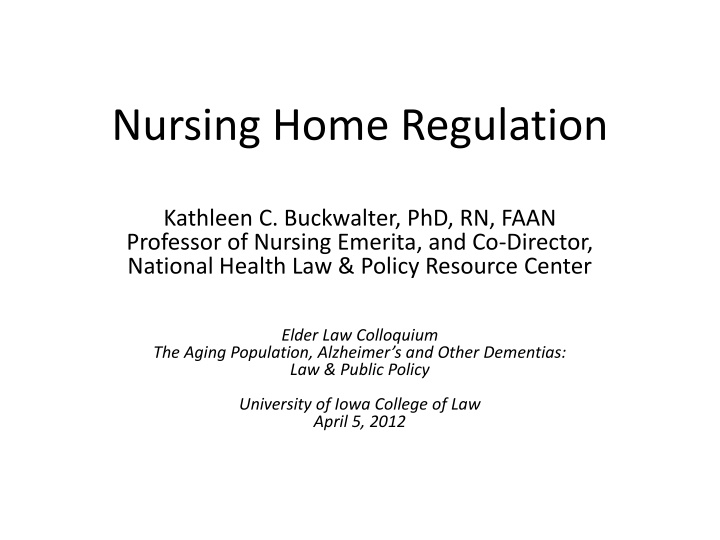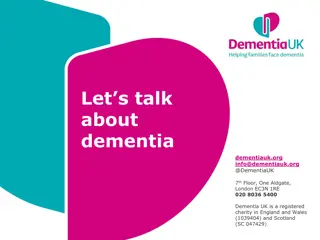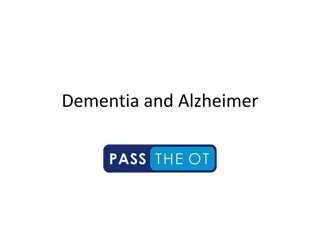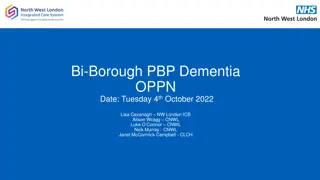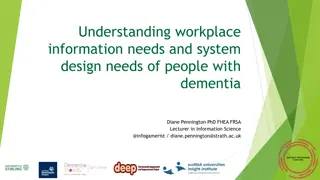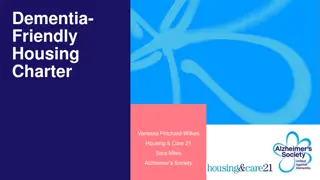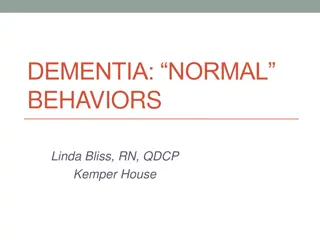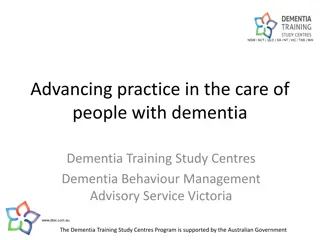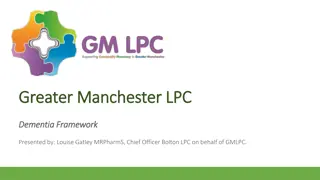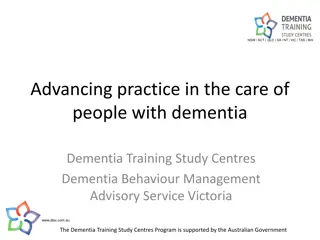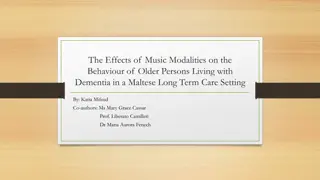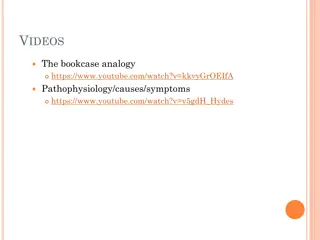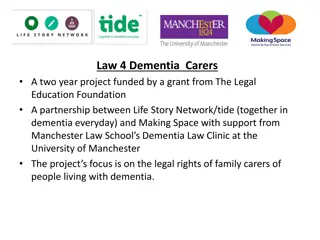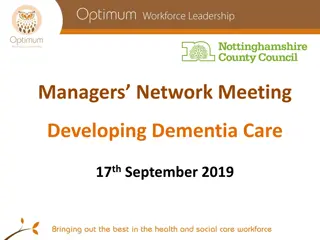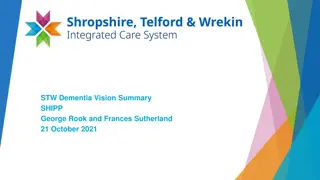Nursing Home Regulation and Quality of Care for Persons with Dementia
This presentation by Kathleen C. Buckwalter discusses the regulation and quality of care in nursing homes, focusing on predictors of institutionalization, the percentage of nursing home residents with cognitive impairment or dementia, and the Medicare/Medicaid certification requirements for quality of care. It emphasizes the importance of addressing patient and caregiver factors, behavior problems, cognitive impairment, and physical health to enhance quality of life for residents with dementia. Providing high-quality, individualized care is essential for meeting the needs of frail elderly residents.
Download Presentation

Please find below an Image/Link to download the presentation.
The content on the website is provided AS IS for your information and personal use only. It may not be sold, licensed, or shared on other websites without obtaining consent from the author.If you encounter any issues during the download, it is possible that the publisher has removed the file from their server.
You are allowed to download the files provided on this website for personal or commercial use, subject to the condition that they are used lawfully. All files are the property of their respective owners.
The content on the website is provided AS IS for your information and personal use only. It may not be sold, licensed, or shared on other websites without obtaining consent from the author.
E N D
Presentation Transcript
Nursing Home Regulation Kathleen C. Buckwalter, PhD, RN, FAAN Professor of Nursing Emerita, and Co-Director, National Health Law & Policy Resource Center Elder Law Colloquium The Aging Population, Alzheimer s and Other Dementias: Law & Public Policy University of Iowa College of Law April 5, 2012
I I. BACKGROUND
I Predictors of Institutionalization Patient Factors Caregiver Factors Behavior Problems Burden Increasing Cognitive Impairment Physical Health Effective approaches to enhance QOL should target some of these factors ADL Impairment Physical Health Decline
I Percent of Nursing Home Residents with Cognitive Impairment/ Dementia In 2009, 68% of nursing home residents had some degree of cognitive impairment. In 2011, 47% of all nursing home residents had a dementia diagnosis in their nursing home record Source: Alzheimer s Association, 2012 Alzheimer s Disease Facts and Figures (2012)
I Quality of Care (QOC) in Persons with Dementia (PWD) Providing consistently high quality of care in nursing homes to a variety of frail very old residents requires that the functional, medical, social and psychological needs of residents be individually determined and met . Institute of Medicine, Improving the Quality of Care in Nursing Homes (1986) at p. 10.
I Medicare/ Medicaid Nursing Home Certification: Quality of Care Requirements General Each resident shall receive and each facility shall provide necessary care and services to attain or maintain the highest practicable physical, mental and psychological well-being of a resident in accordance with the resident s comprehensive assessment and plan of care.
I Medicare/ Medicaid Nursing Home Certification: Specific Quality of Care Requirements Activities of Daily Living Vision and Hearing Pressure Sores Urinary Incontinence Range of Motion Mental and Psychosocial Functioning Nutrition Hydration Nasogastric Tubes Special Needs Unnecessary Drugs and Antipsychotic Drugs Medication Errors Accidents
I Quality of Care Requirements Unnecessary Drugs and Antipsychotic Drugs The facility must ensure residents do not receive unnecessary drugs, defined as a drug use in excessive dosage, for excessive duration, without adequate indications in use, or with adverse consequences. Facilities must ensure residents are not started on antipsychotic drugs unless clinically necessary and that if a resident receives such drugs, efforts are made to discontinue their use.
I Quality of Life (QOL)in Persons with Dementia (PWD) Until recently, identifying positive outcomes to maximize QOL was neglected are of research View the person with AD as an object or problem to be managed vs. person with thoughts, desires, needs that require attention (Keane, 1994; Kitwood, 1997) Stripping of Personhood (Lawton, 1994) vs. understanding Individual perspective and impact of disease on the individual PWD need adequate and continuing treatments in a stable, safe, stimulating environment (Weyer & Schaufele, 2003)
I Promoting emotional well being in persons with dementia (Burgener & Twigg, 2002) Relationships/social interactions/human contact vs pulling away Comfort/freedom from pain Meaningful, pleasant activities (Whitehouse & Rabins, 1992) e.g. art, storytelling, TIMESLIPS Ability to communicate needs (Malott & McAiney, 1995 Recognizing & supporting previous skills and positive behaviors (Buckwalter et al. 1996) Continued intimacy with family (Parse, 1996) Need for normalcy, sense of continuity and personal control
I Indicators of Well-Being in People with Dementia (Kitwood & Bredin, 1992) Assertion of desire or will Ability to express a range of + and emotions Initiation of social contact Social security Self-respect Acceptance of other people with dementia (instit setting) Humor Creativity/Self expression Showing pleasure Helpfulness Relaxation
I QOL for Care Recipient influenced by Caregiver factors (Burgener & Twigg, 2002) Relationship between CG factors and CR QOL outcomes- beyond that accounted for by changes in mental ability Role stress Quality of CG/CR relationship Facilitation of social contacts and activity participation by CG
II II. SPECIAL CARE UNITS
II Driving Forces for Segregated Units better care for dementia victims 1 non-dementia residents prefer separate space 2
II Should demented be segregated? YES Reduce level & complexity of stimuli Protect the nondemented Focus programming Staff believe care is better Some evidence of improved outcomes
II When Lucid and Demented Elders are Housed Together Problems for Lucid Elders: Invasion of privacy Lost or damaged personal property Decreased socialization as resident attempts to avoid encounters with the confused Interrupted sleep Fear of physical harm from the agitated resident
II When Lucid and Demented Elders are Housed Together Problems for Demented Elders: Tranquilizing medication causes decreased mobility, loss of appetite, and dependence in activities of daily living Exclusion from traditional planned activities and subsequent decreased socialization
II When Lucid and Demented Elders are Housed Together Problems for Demented Elders: Negative feedback from caregivers and other residents Increased fear and agitation leading to the use of soft- tie restraints Negative family response to the use of restraints, possible decreased visiting
II What makes Special Units Special? Special It Depends.
II What is a Special Unit? No Standard Definition No Uniform Terminology No Standardized Criteria
II SCU .. a distinct part of a health care facility which is clearly identifiable, containing contiguous rooms in a separate wing or building or on a separate floor of the facility, and for which a special program of care has been approved. (ADRDA Unit Rules Committee, 1988)
II Five Characteristics of Special Units 1) Staff selection and training 2) Activity programming 3) Family programming 4) Physical environment and decor, including separation 5) Admission criteria
II Special vs. Segregated 7 dimensions of care (AAHA) Commitment Philosophy Therapeutic care Physical design Staff Communication Research and education
II Management Modalities for SCUs THERAPEUTIC PROGRAMS Approaches and activities appropriate for resident cognitive and functional status Focus on resident strengths and familiar activities, such as religious, cultural, ethnic rituals
II Management Modalities for SCUs THERAPEUTIC PROGRAMS Group occupational, physical, and activity therapy programs, such as cooking, gardening, dancing, exercise, and sensory stimulation One-on-one activities, such as ball throwing, review of photo albums, and hand massage
II Management Modalities for SCUs INVOLVEMENT OF FAMILIES Encouragement of family participation in activities and care Provision of information and support groups
II Management Modalities for SCUs PHYSICAL ENVIRONMENT Reduction of noxious stimuli Provision for safe wandering Access to outdoors Wayfinding cues Visual, tactile, musical, and other sensory stimulation
II Management Modalities for SCUs STAFF APPROACHES TO CARE Individualized care planning and provision A team approach to care with consistent staffing Behavior modification Minimization of physical and pharmacologic restraints Emphasis on patient dignity
II SCUs -- Legal and Public Policy Issues
II III. Atypical Antipsychotic Drugs
II Pharmacological Interventions For mild-mod BPSD non-drug approaches 1st Psychotropic meds (short term) for severe behavior Manic sxs: Mood stabilizers (anti-convulsants) Agitation/aggression: SSRIs, Mood stabilizers, trazadone Psychotic sx/severe aggression (danger to self/others) -- IM Haldol in crisis. Atypical Antipsychotics Depressive sxs/anxiety: S SSRI antidepressants/benzos
II Meds, con t Adjust to non-pharm approaches Side Effects Black box warnings Off-Label Cognitive Enhancers (Chol. Inhibitors) Modest benefit (Donepezil, rivastigmine, galantamine, memantine)
II Non-Pharmacological Management of Behavioral and Psychological Symptoms of Dementia (BPSD): Best Practices Interventions No easy answers Complicated by changing clinical course Principles of Care: Adjust daily routines Change reaction and responses to behaviors Monitor and adjust the environment, remove triggers Adjust interaction and communication strategies Gould (2007) Williams (2005) (Ballard et al., 2009; Burgener & Twigg, 2002; Smith & Buckwalter, 2005)
Cochrane Reviews and Protocols Selected for Nonpharmacological Interventions These reviews and protocols can be found at: http://dementia.cochrane.org/ orhttp://dementia.cochrane.org/our-reviews Aroma therapy for dementia Cognition-based interventions for healthy older people and people with mild cognitive impairment Cognitive rehabilitation and cognitive training for early-stage Alzheimer's disease and vascular dementia Homeopathy for dementia Interventions for preventing and reducing the use of physical restraints in long-term geriatric care Interventions for preventing delirium in hospitalized patients Light therapy for managing cognitive, sleep, functional, behavioral, or psychiatric disturbances in dementia Massage and touch for dementia Multidisciplinary team interventions for delirium in patients with chronic cognitive impairment Music therapy for people with dementia Non-pharmacological interventions for wandering of people with dementia in the domestic setting Physical activity and enhanced fitness to improve cognitive function in older people without known cognitive impairment Physical activity programs for persons with dementia Reality orientation for dementia II
II Cochrane Reviews and Protocols Selected for Nonpharmacological Interventions (cont) Reviews (cont): Reminiscence therapy for dementia Respite care for people with dementia and their careers Snoezelen for dementia Special care units for dementia individuals with behavioral problems Subjective barriers to prevent wandering of cognitively impaired people Support for careers of people with Alzheimer's type dementia Transcutaneous Electrical Nerve Stimulation (TENS) for dementia Validation therapy for dementia Protocols: Case/care management approaches to home support for people with dementia Cognitive and behavioural interventions for carers of people with dementia Cognitive stimulation to improve cognitive functioning in people with dementia Functional analysis-based interventions for challenging behaviour in dementia Information and support interventions for informal caregivers of people with dementia Multidisciplinary Team Interventions for the management of delirium in hospitalized patients Physical activity for improving cognition in older people with mild cognitive impairment Psychosocial interventions for reducing antipsychotic medication in care home residents
II Misuse Atypical Antipsychotic Drugs Legal and Public Policy Issues
III IV. Culture change
III Culture Change Definitions Culture change, or a resident-centered approach, means an organization that has home or work environments in which: care and all resident-related activities are decided by resident; living environment is designed to be home rather than an institution; close relationships exist between residents, family members, staff, and community;
III Culture Change Definitions, cont d work is organized to support and allow all staff to respond to residents needs and desires management allows collaborative and group decision making; processes/measures are used for continuous quality improvement. Source: The Commonwealth Fund 2007 Survey of Nursing Homes
III Key Areas of Culture Change Establishing inclusive decision-making Reinventing staff roles De-Medicalizing the physical environment Redesigning the organization Creating new leadership practices Source: California Healthcare Foundation, 2008
III Four Stages of Culture Change Stage Features 1-Institutional Model The traditional medical model is organized around a nursing unit without permanent staff assignment. Neither resident nor staff are empowered in this model. Staffing inconsistency limits relationship-building between staff and residents, and depresses job satisfaction. 2- Transformation Model Awareness of the key elements of culture change is pushed throughout the organization via workshops and educational sessions for various departments and types of staff. Permanent staff assignments to units may be made to start the development of communities within the facility. Low-cost physical changes may be introduced, including new furniture, artwork, plants, carpeting, and higher-end finishes such as crown molding.
III Four Stages of Culture Change, cont d Stage Features 3-Neighborhood Model Traditional units are divided into smaller areas. Resident- centered dining may be adopted, eliminating full kitchens. Neighborhood coordinators are sometimes introduced and unique names and physical attributes are developed for each neighborhood. 4-Household Model Self-contained living areas have up to 25 residents. Typically, each household has its own kitchen, living area, and dining area. Staff are self-directed teams who perform a variety of functions. Household management is a collaborative process that places resident preferences first, followed by staff and household capacities. Source: Grant, L., Norton, L. (November 2003) A Stage Model of Culture Change in Nursing Home Facilities. Presented at the 56th Annual Scientific Meeting of the Gerontological Society of America.
